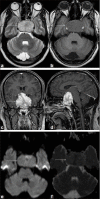Imaging of the pituitary: Recent advances
- PMID: 22029027
- PMCID: PMC3183511
- DOI: 10.4103/2230-8210.84871
Imaging of the pituitary: Recent advances
Abstract
Pituitary lesions, albeit relatively infrequent, can significantly alter the quality of life. This article highlights the role of advanced imaging modalities in evaluating pituitary-hypothalamic axis lesions. Magnetic resonance imaging (MRI) is the examination of choice for evaluating hypothalamic-pituitary-related endocrine diseases. Advanced MR techniques discussed in this article include dynamic contrast-enhanced MRI, 3T MRI, magnetization transfer (MT) imaging, diffusion-weighted imaging (DWI), proton MR spectroscopy, fluorine-18 fluorodeoxyglucose-positron emission tomography, single-photon emission computed tomography, intraoperative MRI, and intraoperative real-time ultrasonography.
Keywords: Computed tomography; imaging; magnetic resonance imaging; pituitary; recent advances.
Conflict of interest statement
Figures






References
-
- Elster AD. Imaging of the sella: Anatomy and pathology. Semin Ultrasound CT MR. 1993;14:182–94. - PubMed
-
- Carpenter MC. 2nd ed. Baltimore, MD: Williams and Wilkins; 1978. Core text of neuroanatomy; pp. 216–35.
-
- Johnsen DE, Woodruff WW, Allen IS, Cera PJ, Funkhouser GR, Coleman LL. MR imaging of the sellar and juxtasellar regions. Radiographics. 1991;11:727–58. - PubMed
-
- Schwartzberg DG. Imaging of pituitary gland tumors. Semin Ultrasound CT MR. 1992;13:207–23. - PubMed
-
- Crenshaw WB, Chew FS. Rathke's cleft cyst. AJR Am J Roentgenol. 1993;158:1312. - PubMed

